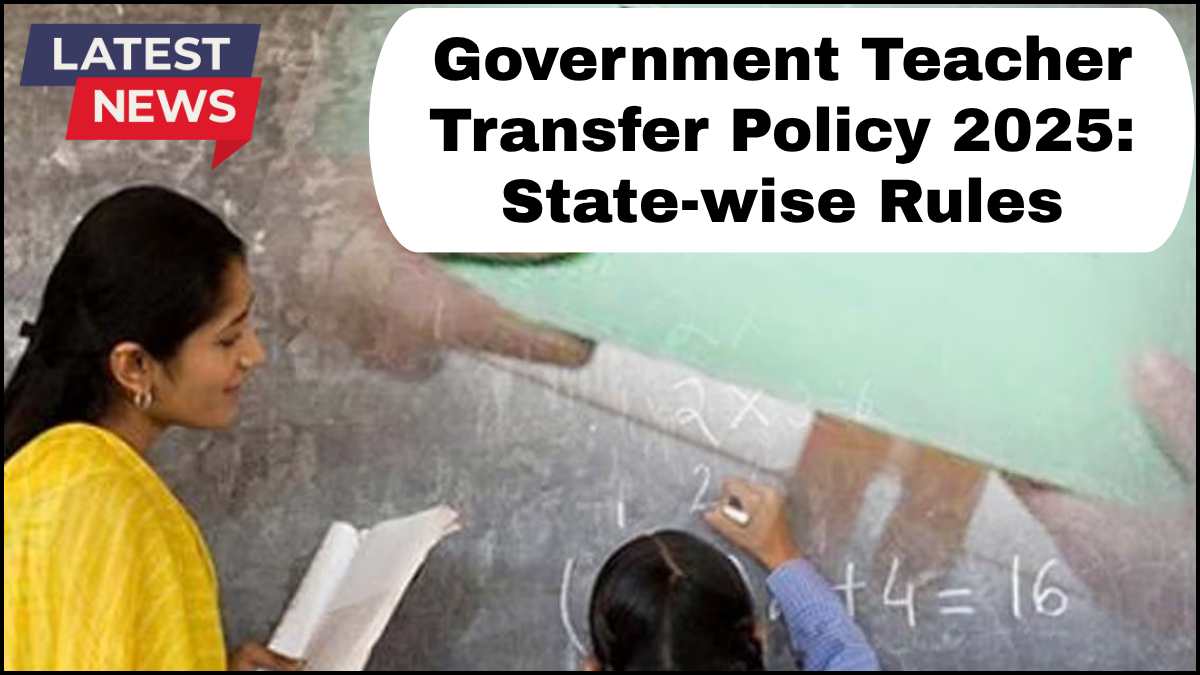The Government Teacher Transfer Policy 2025 outlines the guidelines and criteria for relocating government school teachers from one location to another. It aims to balance educational needs, ensure fair opportunities for teachers, and address staffing shortages in rural and remote areas.
While the central government provides broad directives, state transfer rules vary across India. Each state’s education department frames specific procedures to manage transfers based on service requirements, seniority, personal circumstances, and institutional needs.

Below is a detailed overview of how the 2025 policy works and how states differ in their approach.
Objectives of the Government Teacher Transfer Policy
The core purpose of the Government Teacher Transfer Policy is to create a transparent, merit-based system while maintaining quality education in all regions. The main objectives include:
-
Balancing Teacher Distribution: Avoiding overstaffing in urban areas and shortages in rural schools.
-
Supporting Teachers’ Welfare: Addressing requests based on health, spouse location, or family needs.
-
Improving Educational Outcomes: Ensuring that every school has qualified and experienced staff.
-
Promoting Transparency: Reducing favoritism and political influence in transfer decisions.
Key Features of the 2025 Transfer Policy
-
Online Transfer Portals
Most states have adopted digital platforms to process applications, publish vacancy lists, and issue transfer orders. This shift reduces paperwork and speeds up approvals. -
Seniority and Priority Criteria
Teachers are ranked based on years of service, rural posting history, and special circumstances (such as disability or spouse employment). -
Defined Transfer Windows
Transfers are usually allowed once or twice a year, often before the academic session begins, to minimize disruption to students. -
Mutual Transfers
Teachers in different locations can apply for an exchange transfer, subject to matching eligibility and consent. -
Compulsory Rural Service
Many states require teachers to serve in rural or tribal areas for a minimum period before requesting a transfer to urban locations.
State-Wise Transfer Rules in 2025
Although the core principles are similar, each state’s education department sets its own state transfer rules. Here’s a broad outline of variations:
Uttar Pradesh
-
Uses a point-based system considering service duration, rural postings, and special cases.
-
Online applications are mandatory through the state’s education portal.
Maharashtra
-
Prioritizes transfers for teachers nearing retirement, those with medical conditions, and spouses of government employees.
-
Annual transfer cycle conducted before June.
Karnataka
-
Implements a zone-based system, with teachers required to serve a minimum number of years in a zone before moving to another.
-
Mutual transfers are processed faster if both candidates meet zone requirements.
Rajasthan
-
Preference for teachers completing five years in difficult areas.
-
Additional weightage for female teachers and differently-abled applicants.
Tamil Nadu
-
District-level committees oversee the process, ensuring vacancies are filled based on student-teacher ratios.
-
Online grievance redressal for rejected applications.
Challenges in Implementation
Even with digital systems, challenges remain:
-
High Demand for Urban Postings: Many teachers request transfers to cities, creating rural vacancies.
-
Political Pressure: In some cases, external influence still affects decision-making.
-
Delayed Vacancies Update: Some states struggle to keep online vacancy data current, leading to confusion.
Recent Improvements in 2025
The 2025 update focuses on:
-
Real-time Vacancy Updates to ensure accurate postings.
-
Transparent Merit Lists published online for public review.
-
Grievance Timelines to ensure faster dispute resolution.
Conclusion
The Government Teacher Transfer Policy 2025 is designed to maintain a fair, transparent, and balanced distribution of teachers while addressing personal and professional needs. However, understanding the state transfer rules is crucial, as procedures and priorities vary widely. Teachers are advised to review their state’s specific guidelines before applying to ensure compliance and maximize their chances of approval.
FAQs on Government Teacher Transfer Policy 2025
Q1. What is the main purpose of the Government Teacher Transfer Policy 2025?
The policy aims to ensure equitable distribution of teachers across regions while considering their personal and professional needs.
Q2. Are transfer rules the same across all states?
No. While the central policy gives broad guidelines, each state sets its own state transfer rules based on local requirements.
Q3. Can a teacher request a transfer at any time?
Generally, no. Most states have fixed transfer windows, usually once or twice a year.
Q4. What are mutual transfers?
Mutual transfers allow two teachers to swap postings, subject to eligibility and mutual agreement.
Q5. How can I apply for a transfer in 2025?
Most states have online portals where teachers can submit applications, check vacancies, and track transfer status.
click here to learn more